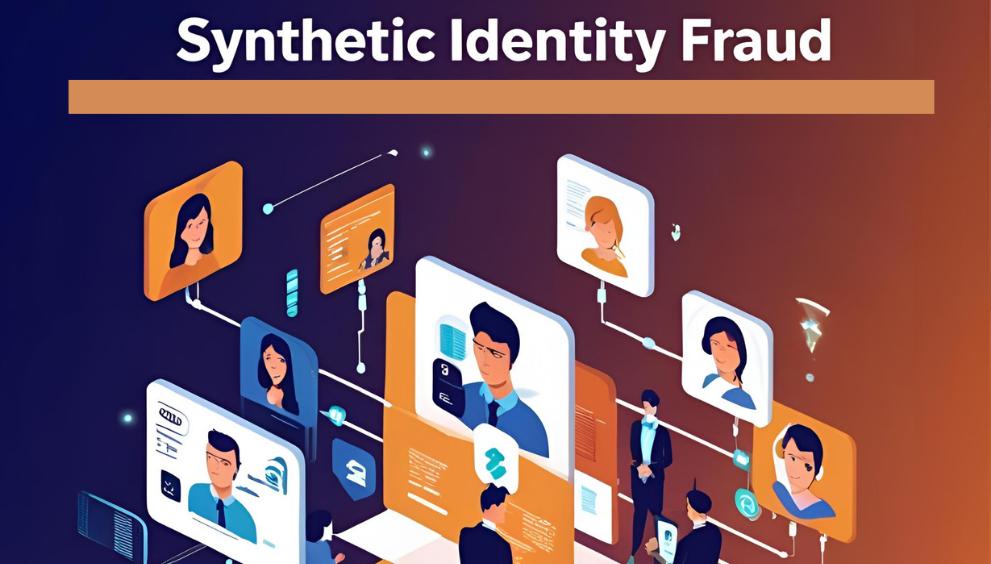Today, it is a day and age of convenience and connectivity, and so security challenges have evolved rapidly, too. Synthetic Identity Fraud is one of the most intricate and rapidly growing forms of financial crime in modern times. Not at all like traditional identity theft, where a crook uses only stolen data from real people, this scam mixes fake info with real data (such as Social Security Numbers) to invent brand new identities that don’t actually exist. These identities may sit undiscovered for years, stockpiling credit and credibility until finally defrauding financial systems of billions. As these scammers are getting smarter and wiser, using basic anti-fraud tools is crucial, not optional.
Businesses, governments, and consumers will need to stay on guard. Fortunately, the fight against synthetic identity abuse has gained a lot of ground with the development of new technologies for fraud detection, such as behavioral analytics, device fingerprinting and real-time identity verification. This blog looks into the mechanics of preventing synthetic identity fraud, the model used by cyber criminals and the key role that Total Security and anti-fraud solutions play to identify and combat these digital imposters.
What Is Synthetic Identity Fraud?
Synthetic identity fraud is when a person creates a false identity by combining real and fake information. One technique a fraudster could use is a valid Social Security Number (frequently of a minor or dead person) paired with a phony name, date of birth, and address. While synthetic identity theft is the end goal (generally meaning the theft or fraudulent use of personal data of an individual, usually to establish synthetic identities), this crime encompasses the entire process of doing so. The U.S. Federal Reserve reports it is now the fastest-growing financial crime in the U.S., responsible for 80% of all credit card fraud losses.
How Cybercriminals Use Synthetic Identities
Creating synthetic identities is a meticulous, step-by-step process that enables cybercriminals to stay under the radar. Here’s how they do it:
- Harvest Data: They obtain real data, such as SSNs, via data breaches or the dark web.
- Fabricate Details: Fake names, addresses, and birthdays are added to form a new identity.
- Build Credit Histories: They apply for credit cards or loans and slowly establish a credit record.
- Monetize: Once the synthetic profile is established, they max out credit and disappear.
What is an Example of Synthetic Fraud?
Imagine someone uses a legitimate SSN that hasn’t been used in credit files, perhaps belonging to a child or recently deceased person, and creates an identity under the name “Alex Smith.” They then open a small credit card account. Over time, this fake person builds a credit score, ultimately securing loans, lines of credit, or government benefits, all under false pretenses. This is the textbook example of synthetic identity manipulation.
Why Traditional Fraud Detection Often Fails
Conventional fraud systems rely on rule-based algorithms: blacklisting suspicious IPs, flagging high-value transactions, or catching unusual login times. While useful for typical threats, these models fall short in identifying synthetic identities. That’s because synthetic profiles often behave exactly like real users, until they cash out. Traditional tools fail because:
- They rely heavily on identity documents that appear valid.
- They cannot cross-reference behaviors across different data silos.
- They do not account for long-term fraud buildup (i.e., “sleeper” accounts).
Hence, modern synthetic fraud detection must go beyond static rules and incorporate adaptive, AI-driven systems.
How to Combat Synthetic Identity Fraud
Enterprises need to deploy comprehensive antifraud frameworks that incorporate AI, real-time data cross-verification, and user behavior analytics. These frameworks must be supported by trained fraud analysts and regulatory compliance experts.
Role of Anti-Fraud Tools in Unmasking Cybercriminals
Modern anti-fraud tools are sophisticated, layered defense systems that go beyond catching obvious red flags. They expose patterns, behaviors, and connections that are invisible to traditional systems. Here’s how:
1. Behavioral Pattern Detection
One of the most powerful ways anti-fraud tools uncover synthetic identity fraud is by analyzing behavioral patterns. Cybercriminals using synthetic identities often behave differently from legitimate users. For example, they might log in at odd hours, repeatedly fail to answer security questions, or navigate a site in unusual ways.
These anomalies are hard to detect manually, but modern fraud detection systems use machine learning to continuously track and assess such behaviors. If a user profile exhibits inconsistent activity, such as applying for multiple financial products in rapid succession or using different browsers and operating systems for each login, it raises a red flag.
2. Device & IP Fingerprinting
Device and IP fingerprinting is a core feature in synthetic fraud detection, allowing anti-fraud tools to identify links between multiple fake accounts. Cybercriminals often create dozens or even hundreds of synthetic profiles using the same device or IP address.
Advanced systems assign a unique fingerprint to each device by capturing details such as operating system, browser type, plugins installed, screen resolution, and language settings. If multiple accounts with different identities are traced back to the same fingerprint, it’s a strong indicator of fraudulent activity.
3. Data Cross-Matching & Real-Time Identity Validation
Real-time data cross-matching is a key feature in identifying synthetic identities. Fraudsters often combine real data (like a legitimate Social Security Number) with fake elements (such as a made-up name or address). Anti-fraud tools counter this by cross-verifying the provided identity details against reliable sources, such as credit bureaus, national ID registries, utility databases, or KYC records. For example, if someone applies for a loan using an SSN that belongs to a minor or a deceased person, the tool instantly flags the anomaly.
4. Link Analysis and Fraud Ring Detection
Synthetic identity fraud rarely happens in isolation; it is often orchestrated by organized cybercriminal networks. Link analysis helps uncover these networks by identifying relationships between fraudulent profiles.
Anti-fraud tools map common data points, such as shared email domains, reused phone numbers, mailing addresses, or device fingerprints, across multiple synthetic identities. For instance, if five different user accounts, each with different names and SSNs, are linked to the same contact number or device ID, that becomes a strong indicator of a coordinated fraud ring.
Features of Modern Anti-Fraud Tools
To effectively tackle synthetic fraud, today’s tools come equipped with a range of features:
- Real-Time Identity Verification
- Device & Network Fingerprinting
- Behavioral Biometrics
- Graph Analytics & Relationship Mapping
- Machine Learning-Based Anomaly Detection
- Geolocation & Time-Zone Mismatch Alerts
- Automated Risk Scoring
Identify Key Indicators of Synthetic Identity to Prevent Fraud
Here are some common warning signs:
- Credit file established recently despite the SSN being old
- Multiple applications from the same IP/device
- Unusual pattern of small transactions followed by large withdrawals
- Slight variations in name/email/phone across different accounts
- Suspicious address history or P.O. boxes only
- Inconsistent biometric or behavioral traits
These indicators, when detected early, can save organizations from massive losses.
Regulatory and Compliance Landscape
Regulators across the globe are now waking up to the risks of synthetic identity crime. In the U.S., the Financial Crimes Enforcement Network (FinCEN) is pushing for stricter KYC practices. India’s RBI guidelines and UIDAI protocols mandate biometric KYC and periodic risk assessments for financial institutions. Globally, AML (Anti-Money Laundering) and FATF standards now cover synthetic ID risk as part of their compliance checklists.
Non-compliance doesn’t just result in financial loss; it invites hefty fines, reputational damage, and even criminal liability.
Staying Ahead of Synthetic Fraud Threats
As fraud tactics evolve, we need to continue to improve our defenses. Synthetic identity fraud isn’t going anywhere; it’s a persistent threat that requires ongoing attention. Security solutions designed to stop fraud before it happens, such as Quick Heal’s Total Security, provide real-time identity analytics, malware removal, and proactive behavior monitoring.
A complete solution to protect both end-users and businesses from nefarious parties is by combining endpoint protection and fraud analytics. Prevention, powered by data and intelligence, is the most resilient armor we can construct against tomorrow’s fraud.
Frequently Asked Questions
-
How can synthetic identity fraud be prevented?
Leverage real-time identity verification tools, add biometric authentication and cross-check user details against trusted third-party databases. As a consumer, keep an eye on your credit reports and protect your personal information.
-
What are the warning signs of synthetic identity theft?
Recently created credit profiles, discrepancies on identity information, frequent credit requests, IP/device sharing across accounts and suspicious validation behavior.
-
How should I protect myself from identity fraud?
Implement a layered security approach leveraging anti-fraud solution, behavioral analytics and identity verification solution. For personal users, options like Quick Heal Total Security come with robust malware protection and suspicious activity notifications.
-
What is a synthetic validity test?
It’s a method used by fraud detection systems to evaluate whether an identity's components (SSN, name, date of birth) correlate in public databases. Failing this test usually indicates a synthetic profile.
-
How can biometrics fight back against rising synthetic identity fraud?
Biometric systems (like fingerprint and facial recognition) are extremely hard to fake. They ensure that only genuine, living individuals can complete high-risk transactions, significantly reducing fraud risk



